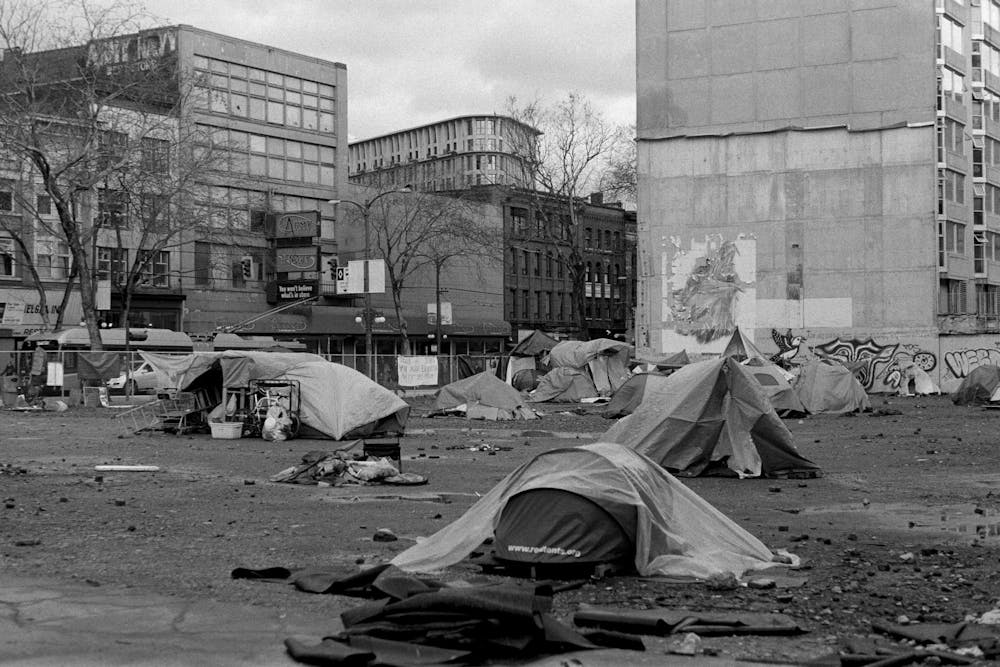I spent the summer after my freshman year working at Andre House, a soup kitchen and drop-in service center for people experiencing homelessness in Phoenix. Andre House is located in the middle of what once was known as "The Zone," a large homeless encampment located near the city's capital. However, in spring 2023, local business owners prevailed in a lawsuit against the city of Phoenix, ordering the city to clear all tents from The Zone. The Zone grew to its massive size of approximately 1,000 people due to a 2019 9th Circuit Court ruling that decided it was unconstitutional to prosecute citizens living on the streets when an insufficient number of shelter beds were available. However, in 2023, a judge ruled that the city of Phoenix was responsible for failing to address the issue and for letting a public nuisance continue. Despite lengthy battles with the ACLU, The Zone was cleared, with hundreds of chronically homeless individuals displaced. Now, the city of Phoenix is continuing to scramble to find long-term solutions for hundreds of unsheltered people.
The clearing of The Zone is not an isolated phenomenon. Around the nation, countless cities — such as Portland, Oregon, and San Francisco — have taken steps to clear out encampments, placing greater restrictions on public camping. The presence of homeless encampments has caused many to question the sufficiency of the Housing First model. Housing First is the idea that once chronically homeless individuals are placed into secure housing — "Housing First" — they are better suited to tackle other issues, such as addiction, that may keep them from securing long-term housing. Thus, instead of traditional strategies that enforce sobriety and other standards prior to housing placement, proponents of Housing First typically support low-barrier, permanent supportive housing, which first places people in housing, and then gives them a choice to connect with supportive resources afterward.
For many, the widespread use of the Housing First method has created hope that chronic homelessness in America could, someday, be a thing of the past. After all, the statistics that some organizations claim are extremely hopeful — the National Low Income Housing Association reported in a 2004 study that the Housing First model is more likely to get people out of homelessness, with 79% of individuals in Housing First programs remaining stably housed compared to just 27% in abstinence-based programs. Still, growing public discontent amidst the increasing presence of large unsheltered populations has led to a call for the clearing of homeless encampments along with general criticism of Housing First, with politicians such as Ohio Senator J.D. Vance arguing that the model ignores the root causes of homelessness. However, many remain convinced of the efficacy of the model. Thus, in attempts to continue getting people sheltered, many cities are experimenting with unique ways to continue, despite opposition, getting unsheltered people off the streets and into housing before addressing other underlying issues.
One example of an innovative application of the Housing First model is the Community First! Village, located just outside of Austin, Texas. The community, which houses approximately 400 residents, is made up of about 200-square-foot tiny homes, providing residents with shelter in which they are allowed to stay permanently. All residents pay rent, and some have jobs within the village. Some argue that the homes fail to meet housing standards, with most residents only having access to communal bathrooms and kitchens. However, for many residents, it seems that the low cost of living, alongside the sense of community the village provides, is proving to be much more effective than traditional housing models.
A second low-barrier initiative being used to get people into housing is Motels4Now (which will soon evolve into the New Day Intake Center), located here in South Bend. Motels4Now was founded to provide a solution to an encampment that arose during the COVID-19 pandemic. It converted the vacant Knights Inn Motel into stable housing for over 100 people. While Motels4Now is controversial, proponents worry that, without Motels4Now, another homeless encampment would form in South Bend.
It would be foolish to claim that any one of these strategies is a one-size-fits-all solution to the incredible intricacies of our nation's housing and homelessness problem. However, they provide hope that, with solutions tailored to local needs, people can be permanently brought out of chronic homelessness. With ingenuity and compassion at the forefront — whether the ultimate solution ends up being Housing First, or another model — we can work for a nation in which all people are provided with the dignified support they need to rebuild their lives.
Leah Moody is a third-year student living in Flaherty Hall. She is from Cincinnati, Ohio, and is studying Economics, Philosophy, and Theology. She currently serves as the vice president of BridgeND.
BridgeND is a multi-partisan political club committed to bridging the partisan divide through respectful and productive discourse. It meets bi-weekly on Mondays at 7 p.m. in Duncan Student Center to learn about and discuss current political issues and can be reached at bridgend@nd.edu.










